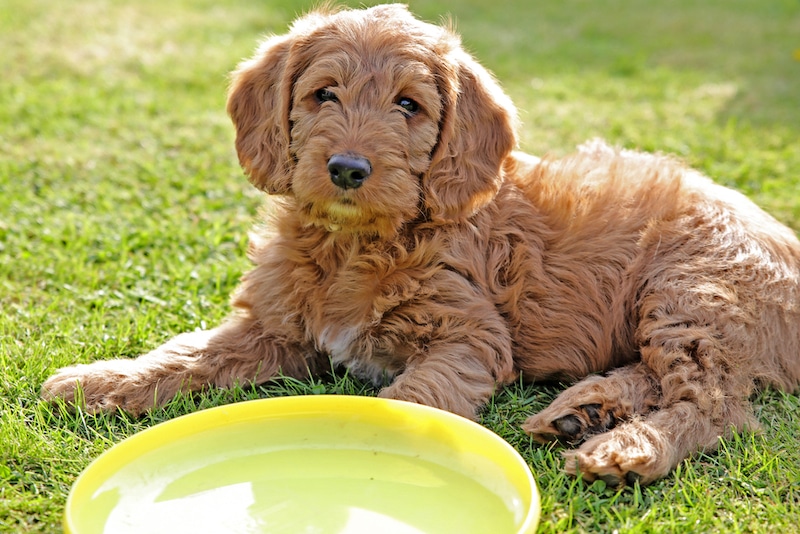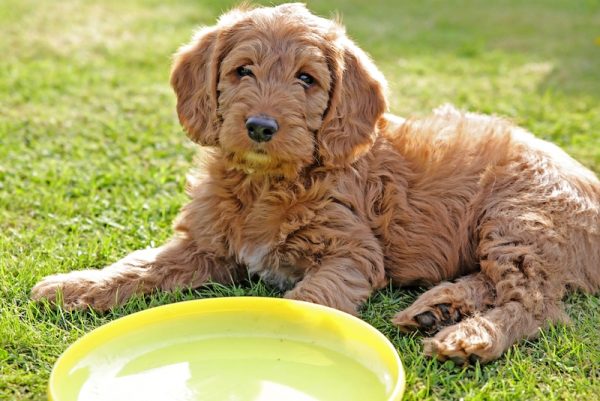Click Below to Skip Ahead
If you’re looking for a pet dog that’s playful, energetic, and a cross between a couple of different designer breeds, then the Petite Labradoodle fits the bill to a tee. This designer breed is crossbred between a Cocker Spaniel and a Labrador Retriever, then crossbred even further with a Toy Poodle.
The result is a Petite Labradoodle that grows to around 15 inches and won’t get over 30 pounds. This pup already goes against the norm with its crossbreeding. Still, it goes even more against the norm because part of its parentage is already a designer breed, meaning the Labradoodle itself.
Breed Overview
Height:
12 to 15 inches
Weight:
15 to 30 pounds
Lifespan:
10 to 15 years
Colors:
Chocolate, cream, gold, caramel
Suitable for:
Apartments, houses, families who have active children
Temperament:
Playful, energetic, loyal, obedient, intelligent
This breed is super intelligent, has a life span of up to 15 years, and works great in apartments or houses. The perfect pet for families with active children, there’s very little not to love about this breed of dog.
If you’re considering purchasing or adopting a Petite Labradoodle, then you’ll want to know everything you can about the breed before making a final decision. In this guide, we’ll discuss what you need to know before you buy a Petite Labradoodle puppy, a few facts about the breed you might not have known, and quite a bit more.
Petite Labradoodle Puppies
The Petite Labradoodle is one of the most popular designer dogs in the United States. They are lovable, loyal, energetic, sociable, and not too bad to train. In most cases, the Petite Labradoodle you get from a breeder with be a fourth Labrador, a fourth cocker spaniel, and a fourth toy poodle. This method of breeding is called the Australian method. There are two methods of breeding to get the Petite Labradoodle, with this one being the most common and the most accepted. Make sure to talk to the breeder you choose to ensure the method you want is the one he uses.
A medium-sized dog, your Petite Labradoodle, won’t grow very big, topping out at maybe 30 pounds and standing 15 inches tall. This breed has a round head and adorable floppy ears that hang down and over their cheeks.
Depending on the parent she takes after, her coat could be silky and curly or coarse and wooly. That you’ll have to see when you purchase or adopt your little bundle of furry joy. However, if you’re looking for a hypoallergenic dog, you’ll want to talk to the breeder about the coarse and wooly Petite Labradoodle, if at all possible, since they are low shedders.
Now that you know what you’re getting into when purchasing or adopting a Petite Labradoodle, we’ll move into a little more about the price and a few facts you should know as well.

Temperament & Intelligence of the Petite Labradoodle
As previously stated, the Petite Labradoodle is extremely intelligent due to its Poodle parentage. It’s also a loving, caring, affectionate family dog that any active family would enjoy having around. You’ll be surprised at how much this breed enjoys life. She’s energetic, playful, and enjoys having fun with her family.
She’s also pretty good at entertaining herself, so she doesn’t have to be always up under a family member. This breed is never aggressive but is also very loyal to her family. As stated before, this breed has such an even temperament that they are used as service dogs quite often. A friendly, intelligent pup, you can’t go wrong with a Petite Labradoodle.
Are These Dogs Good for Families? 👪
The Petite Labradoodle seems to have been made to be part of an active family. Full of energy and always ready to play, children love this breed because you can often find the dog being goofy and silly right along with them.
The fact that this dog looks like a cute little teddy bear adheres to children everywhere. If you have several people in your family who are active and love to play, you’ll easily be able to give this breed the exercise, training, and love they need to be healthy and happy for years to come.
However, it’s important to note that just as with any dog or pet, you need to socialize and train your Petite Labradoodle from an early age to ensure she gets along well with children.
Does This Breed Get Along with Other Pets? 🐶 😽
This breed gets along quite well with other dogs and other pets in general. Make sure to train and socialize your Petite Labradoodle as a puppy by taking her to the dog park, out for walks, and to be around strangers and other pets to ensure this remains true as she gets older.
It’s essential to remember that this breed does have the Labrador Retriever nature as well, which could see them chasing smaller animals around the yard, especially as a puppy before she’s trained properly.
Things to Know When Owning a Petite Labradoodle
Now that you know about the parentage, costs associated with, and a few other facts about the Petite Labradoodle, you’re ready to go out and purchase or adopt one of your very own.
Now, it’s time for us to tell you the food and diet requirements, how much exercise and training your pet might need, and what health conditions to watch out for. We’ll also go into the differences between male and female Petite Labradoodles and their grooming needs as well in the next section.
Food & Diet Requirements 🦴
While this breed is small to medium-sized, they are very active. It’s recommended that you feed her twice a day with a total of 1.5 to 2 cups of food. Her food should be dry and be high-quality food. Give treats sparingly to make sure she stays the ideal weight.
If you’re worried about your Petite Labradoodle gaining weight or are unsure what food and diet she needs, contact your vet for help. He’ll let you know the best choices for your individual puppy.
Exercise 🐕
While small, the Petite Labradoodle loves to play and is quite active and energetic. While this puppy can adapt easily to apartment life, it is great if she has a fenced-in yard to play and run in. Make sure to take her on one long walk a day and to get outside to play with her. Whether it’s Frisbee, tossing a ball, or just running around together, she’ll love the companionship and exercise.
This breed loves to play in water and needs games that challenge them mentally also.
Training 🎾
Because of her mixed parentage, this breed is intelligent, eager to please her family, and listens to what she’s told to do quickly. All these things combined mean that she’s easy to train. However, you do need a firm hand with her and plenty of treats and praise to go around if you want her to listen.
Never be mean to or hit a dog to get them to do what you want. Not only is it abuse, but it could also backfire on you badly. Instead, make sure to train and socialize your Petite Labradoodle early on, so she can grow into the loving, gentle dog she’s meant to be.
Grooming ✂️
The Petite Labradoodle needs daily brushing to keep tangles from forming in her coat. Give her a bath with a high-quality dog shampoo when it’s needed, but not too often. Trim her nails if they get too long, making sure not to cut too far down. Make sure to brush her teeth at least twice a week and take her in for regular checkups for her teeth and her general health.
Clean her ears gently one time a week, but never stick anything into her ears. If you’re worried that you can’t handle grooming, nail trimming, or cleaning her ears, make an appointment with a reputable groomer instead to take care of the job for you.
Health and Conditions 🏥
As with any other pet out there, the Petite Labradoodle has severe and minor health conditions that you need to be on the lookout for. There are conditions that your dog may inherit from its parents, but that doesn’t mean that these conditions will for sure present themselves.
We’ll give you a list of the most common serious and minor health problems to keep an eye out for with your pet Petite Labradoodle.
- Retinal atrophy
- Bloat
- Ear infections
- Allergies
- Obesity
- Exercise-induced collapsing
Keep an eye out for the minor and severe conditions that are possible in this breed of dog. If you see any symptoms of the above, make an appointment with your vet for diagnosis and further treatment options.
 Male vs Female
Male vs Female
There are very few differences between the male and female of this breed to discuss. It has been reported that the male tends to be a slight bit friendlier than his female counterpart. However, the difference is so slight as to almost not matter at all.
3 Little-Known Facts About the Petite Labradoodle
Now that you know about what it’s going to cost to adopt your petite Labradoodle and a little of what’s involved, we’ll let you in on a few facts about this adorable breed you might not have already known.
1. This Breed Makes a Great Companion Dog
Since this breed has the intelligence of a poodle, it’s easy to train them to be service dogs. They make great companions for families with active children as well.
2. This Breed Can Be Hypoallergenic
It is possible that you can purchase a Petite Labradoodle that’s hypoallergenic. However, that’s according to the coat they inherited from their parents. Unfortunately, not all are, so make sure to check with the breeder before making a final decision.
3. This Breed is Extremely Popular
Celebrities love this breed, and they’re extremely popular now because of their size, nature, and how adorable they are.
Final Thoughts
This is it for our guide on the Petite Labradoodle and what you should know before you make that decision to go out and purchase or adopt one.
Make sure that you’re prepared to deal with the costs, training, and love it takes to bring a dog into your family, no matter what breed the dog is. Follow the tips and advice above, and you’ll have a loyal, happy, energetic, loving companion for a great many years to come.
See also:
Featured Image Credit: anii Brown Photography, Shutterstock











